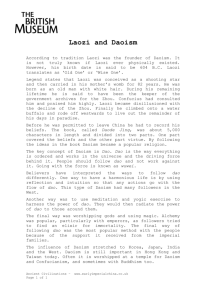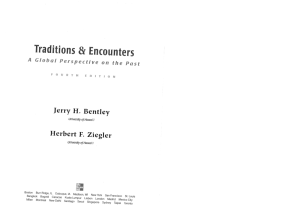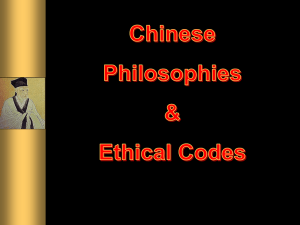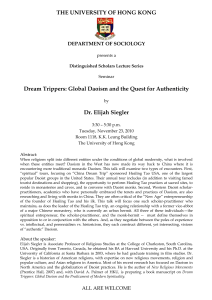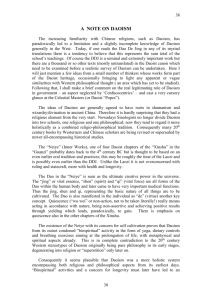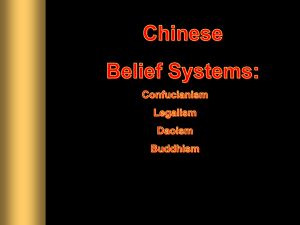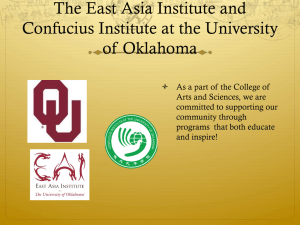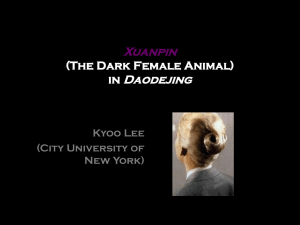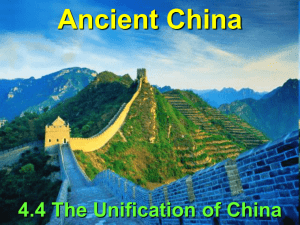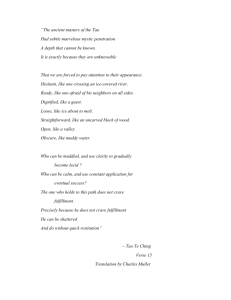Taoism
advertisement
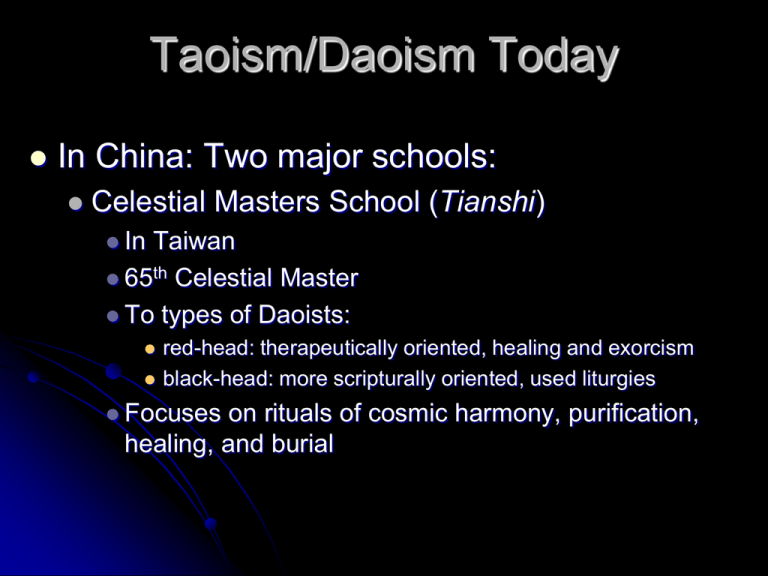
Taoism/Daoism Today In China: Two major schools: Celestial Masters School (Tianshi) In Taiwan 65th Celestial Master To types of Daoists: red-head: therapeutically oriented, healing and exorcism black-head: more scripturally oriented, used liturgies Focuses on rituals of cosmic harmony, purification, healing, and burial Complete Perfection School (Quanzhen) In Hong Kong and China Monastic Promote selfcultivation, Qigong health practice •Jingxiu (Karine Martin, from Montlucon, France •Ph.D. in Medical Science, University of Paris •Priestess of the 32nd generation of Quanzhen Daoism Expression/Social Functions of Daoism Contemporary Daoism finds its expression in rituals Two categories Rites of Purgation (Zhai) Jiao-Offering Rites (Jiao) Three major types of rites Secret ceremonies Semi-public ceremonies Requiem service for the dead: Funerary rite Universal salvation rite (Pudu) Qigong and Taiji quan Qigong: (energy exercise) practices divided into two groups: martial Healing Qigong forms: based on the imitation of certain animals The Crane pattern The Five Animals Pattern, The Snake and Tortoise Pattern Taiji quan: Daoist Temple Baiyun Guan (White Cloud Monastery) in Beijing Nomenclature Common terms/ phrases 氣 Tao/Dao, Te/De, Wu, you Daoism/Taoism, Daoist/Taoist, Laozi/ Lao-tzu, Zhuangzi/Chuang-tzu, qi, yin-yang 氣 Confucius--/Kongzi-K’ung-tzu--Master Kong-Master K’ung Confucian or Confucianist Confucianism Ren/Jen (Humanness, humanity) Yi (I, Rightness, Righteousness) 仁 義 wanwu (myriad things/creatures) tianxia (all-under-heaven) Inner alchemy, outer alchemy Ritual, self-cultivation, longevity techniques, qigong, fengshui, Names of dynasties/periods: the Zhou dynasty, the Warring State Period, the Qin Dynasty, the Han Dynasty, the Tang Dynasty, the Song Dynasty, the Ming Dynasty, the Qing Dynasty Daoist schools: Tianshi (Zhengyi ), or Celestial Masters Quanzhen, or Complete Perfection Taoism/Daoism in the US Known because of many translations of the Daode jing/Tao te ching. Became popular through the introduction of Taiji quan in the 1950s and 1960s Organized Daoist communities appeared in the 1980s Two camps in Asian communities: Ritual lineages (based on the Celestial Masters, Tianshi) Self-cultivation (based on the Complete Perfection, Quanzhen) A Long History of Taoism/Daoism Taoism/Daoism has a long and highly complex history that began from 5th century BCE or earlier Developed and evolved throughout Chinese history, with new elements added to respond and react to social and political changes and challenges Became an integral part of Chinese culture and cannot be excluded from the discussion of Chinese history, religion, philosophy Tao-te ching/Daode Jing (Lao-tzu), the text Three extant texts (before 2009) Received/standard text (3rd century AD), often called Wang Bi text 81 chapters, with title the Laotzu/Laozi 1-37 chapters—Tao/Dao ching/jing 38-81 chapters—Te/De ching/jing Mawangdui text, a silk manuscripts (200 BCE, 1973) Does not bear a title Dao jing and De jing are in the reverse order Contains a few hundred more characters than Wang Bi’s text Guodian text (ca. 4th BCE, 1993), in inscribed bamboo strips 2/5 of what was to become the Daodejing were present When and by whom the first Lao-tzu text was written remain a mystery Beida Laozi text: (ca. late 1st century BCE) . Also in inscribed bamboo slips, but more complete, more organized Two parts: Laozi Shangjing, Laozi Xiajing Mawangdui Excavation 1972-1974, Hunan, Chansha Two saddle-shaped hills that contain tombs belonging to the first Marquis of Dai and his family members Many artifacts and three corpses were discovered Tomb no. 1: Lady Xinzhui 辛追 Tomb no. 2: Marquis of Dai軑侯, Li Cang 利蒼 Tomb no. 3: son of Li Cang and Xinzhui A T-shaped silk banner in tomb no.1 Modern reconstruction of Lady Xinzhui Lady Xinzhui’s Mummified body Guodian Laozi unearthed In 1993 Three sets of bamboo slips: A-39, 1090 characters B-18, 389 characters C-14, 270 characters The Pre-manuscript Tradition The excavated manuscripts support this theory: The text called Lao-tzu (Laozi) cannot and should not be ascribed to a single, historically identifiable author It is a collection of separate sayings, transmitted orally before they were written down The written text underwent a long and complex editorial and commentarial process The Nature of those sayings or verses Some sound like oracles Some like riddles Some seem to be ritual formulas Meant to be learned by heart and transmitted orally Scholars are still asking the questions about author(s) and date Historical account says Laozi and his writing of the text Was Laozi the author ? Biography of Laozi in the The Grand Scribe’s Record says: A meeting between Laozi and Confucius took place Laozi was asked by the frontier guard to write the text in 5000 characters to leave behind his wisdom, when traveling westwards “Laozi Riding An Ox”, Song Dynasty Silk tapestry Water color painting By Fachang Song Dynasty Meaning Lexical meaning of Tao/Dao and audience of the text Etymological Tao/Dao in the Tao- te ching Tao/Dao and Wu Audience Political leaders of the Warring States Period An organic world/cosmic system Dao can be understood in these senses metaphysical sociopolitical individual cultivation Analogy used to associate natural world and human world An organicism/organism (whether it is a complete/perfect system or not) Holographic universe A prescriptive, advisory system than a descriptive, explanatory system Focuses on result, effect, “how to” rather than “truth” or “ultimate truth” Assumes that natural or cosmic order and structure correspond to that of human world Suggests that everything in the world is utterly interrelated Tao/Dao and Wu The fundamentals of Daoism: – You and wu – Being and non-being – Emptiness and fullness – Presence and nonpresence Dao and Wu – cosmology and cosmogony – productive force and source of all things – the principle/function and the phenomenon/state (of being or non-being) Reappraisal of the TTC/DDJ The TTC/DDJ continued to appeal to the elite class throughout Chinese history the TTC regained currency in the Ming dynasty—a time when syncretic religion became popular The brevity and ambiguity of the text opens room for new interpretations Commentaries on the text accrued from early China to the present time, with Western scholars participating in the effort Studies of newly unearthed Daoist texts reshape our understanding of the change and evolution of Daoism Scientists, e.g., Fritjof Capra and David Bohm, are inspired by the DDJ’s notion of interconnectedness of all things Example of Differences in Exegeses The ways that can be walked are not the constant Way; The names that can be named are not the eternal name. The nameless (wu-ming 無名)is the origin of the myriad creatures; The named (you-ming 有名) is the mother of the myriad creatures. Therefore, Always in order to observe its wondrous subtleties Always so be without desire (wuyu 無欲) have desire (youyu有欲) that you may observe its manifestations. Both of these derive from the same source; They have different names but the same designation. Mystery of mysteries The gate of all wonders! (TTC/DDJ, 45/1) See an alternative translation in the next slide The gist of this verse is: The Tao/Dao is ineffable, undefinable, unexplainable An Alternative Reading the Dao is “Nonbeing,” “Nonentity” from which “Being,” “Entity” emerges. The ways that can be spoken of are not the constant Way; The names that can be named are not the eternal name. Wu (無), is what is used to name the origin of heaven and earth (tiandi 天地) You (有), is what is used to name the mother (formation) of the myriad creatures Therefore, always observe “Wu” To see the wondrous subtitles of the Way, In the meantime, observe “You” To see its manifestation Both “Wu” and “You” emerge from the same source (Dao) but have different names Both are mysterious, [With Wu (nonbeing] being the most mysterious [and You (being] the gate of all wonders 1st Paradox: Define the Unnamable Tao/Dao There was something featureless yet complete, born before heaven and earth; silent--amorphous-it stood alone and unchanging. We may regard it as the mother of heaven and earth. Not knowing its name, I styled it the “Way.” If forced to give it a name, I would call it “great.” Being great implies flowing ever onward, “Flowing ever onward” implies far-reaching, Far-reaching implies reversal (TTC/DDJ, 69/25) Describe the ineffable: The Amorphous Tao/Dao We look for it but do not see it; we name it “subtle.” ( 微wéi ) We listen for it but do not hear it; we name it “rare.” (希xī ) We grope for it but do not grasp it; we name it “serene.” (夷yí ) These three cannot be fully fathomed, Therefore, they are bound together to make unity. (一yī ) Of unity, its top is not distant, (there is nothing more encompassing above it) 謬miù its bottom is not blurred. (and nothing smaller below it.) 物wù Infinitely extended and unnamable, It returns to nonentity.無wú 物wù This is called “the form of the formless,無wú 狀zhuàng 之zhī 狀zhuàng “the image of nonentity.” 無wú 物wù 之zhī 象xiàng This is called “the amorphous.” Following behind it, You cannot see its back; Approaching it from the front, You can not see its head. Hold to the Way of today To manage the actualities of today, 今jīn 之zhī 有yǒu Thereby understanding the primeval beginning. This is called “the thread of the Way” 道dào 紀jì
